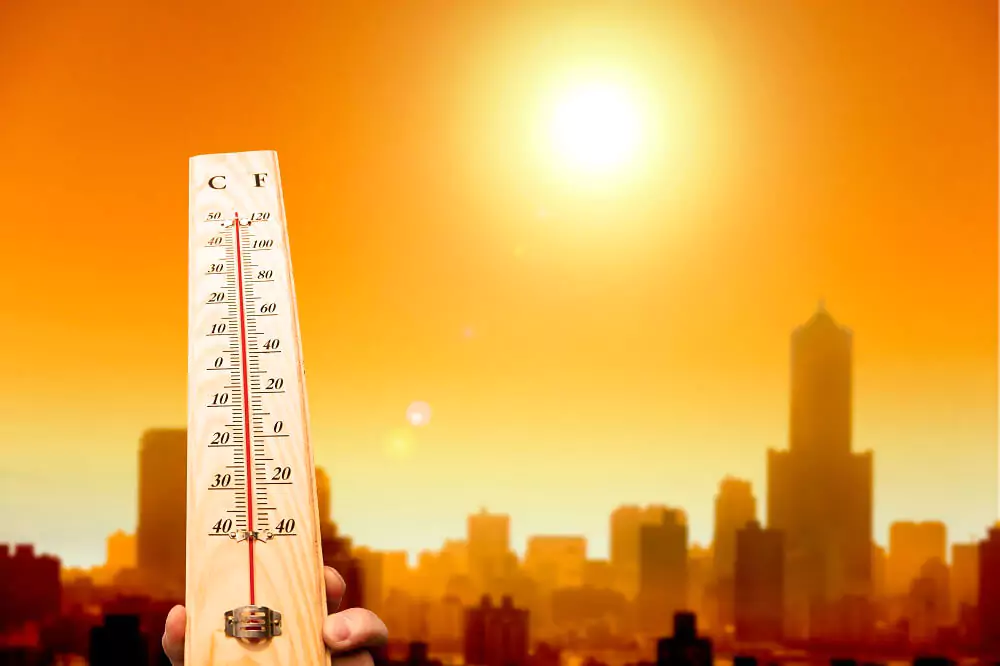India’s Urban Heat Islands (UHI) – 2024 Report on Rising City Temperatures
The Urban Heat Island (UHI) effect is a major environmental challenge affecting Indian cities. Due to rapid urbanization, deforestation, concrete infrastructure, and increased energy consumption, urban areas are experiencing significantly higher temperatures compared to rural surroundings.
Key Facts from 2024 Report on UHI in India
- Urban areas in India are 1.3°C – 2.4°C hotter than nearby rural regions at night.
- Delhi, Mumbai, Hyderabad, Bangalore, Ahmedabad, and Chennai show UHI intensities above 2°C.
- Heatwaves in 2024 recorded temperatures exceeding 50°C in major cities.
- 42 major Indian cities have reported increasing UHI effects over the past decade.
Why It Matters?
- Rising city temperatures impact human health, energy demand, and climate change adaptation.
- Unplanned urban expansion & deforestation are making Indian cities vulnerable to extreme heat.
- The Government of India has introduced several UHI mitigation strategies under AMRUT, Smart Cities, and Green Urban Guidelines.
Understanding the Urban Heat Island (UHI) Effect
What is the UHI Effect?
The UHI effect occurs when urban areas experience significantly higher temperatures than rural surroundings due to:/p>
- Loss of natural vegetation – Less shade & cooling from trees.
- Concrete, asphalt, and glass surfaces – Absorb and retain heat.
- High-rise buildings & narrow streets – Trap heat and reduce airflow.
- Increased energy consumption – Excess heat from air conditioners, vehicles, industries.
- Air pollution & greenhouse gas emissions – Intensify heat retention.
Key Insight:Urban surfaces (e.g., roads, rooftops) can reach 50-70°C on hot summer days, significantly raising city temperatures.
Types of Urban Heat Islands (UHI)
| Type | Description | Measurement |
|---|---|---|
| Surface UHI (SUHI) | Temperature differences on land surfaces due to materials like asphalt & concrete. | Measured via satellite imagery. |
| Canopy UHI (CUHI) | Temperature differences in the air at street level (~2m above ground). | Measured using thermometers in urban & rural areas. |
| Boundary Layer UHI | Heat trapped in the atmosphere above cities due to air pollution & emissions. | Measured using weather balloons & remote sensing. |
Key Insight:UHI is more severe at night because concrete and asphalt retain heat for long periods.
Cities Most Affected by the UHI Effect in India (2024 Report)
| City | Average UHI Intensity (°C) | Primary Causes |
|---|---|---|
| Delhi | 2.2 – 2.9°C | Pollution, high-rise buildings, loss of tree cover |
| Mumbai | 1.5 – 2.5°C | High humidity, dense urbanization |
| Hyderabad | 1.9 – 2.4°C | Heat-trapping surfaces, loss of lakes |
| Bangalore | 1.8 – 2.3°C | Shrinking green spaces, deforestation |
| Ahmedabad | 2.0 – 2.8°C | High cement usage, poor ventilation |
| Chennai | 1.6 – 2.2°C | High-rise construction, low urban greenery |
Key Trend:Airports, industrial zones & commercial hubs are the hottest spots in urban areas.
Causes of the UHI Effect in India
| Cause | Impact on UHI |
|---|---|
| Loss of Green Cover | Fewer trees reduce natural cooling. |
| Concrete & Asphalt Roads | Absorb more heat than natural surfaces. |
| Traffic & Industrial Pollution | Releases heat-trapping greenhouse gases. |
| High-Rise Buildings & Urban Density | Trap heat, reducing ventilation. |
| Increased Air Conditioning Use | Excessive heat from AC units increases temperatures. |
Key Trend:Indian cities lost 30% of their green cover between 2000 and 2020, increasing UHI intensity.
Impacts of UHI on Indian Cities
Human Health Crisis
- Heat strokes & dehydration – Over 17,000 heat-related deaths in India (2004-2023).
- Increased respiratory illnesses – Worsened by smog & air pollution.
- Greater impact on vulnerable groups – Slum dwellers, daily wage workers, elderly, children.
Rising Energy Demand
- Increased air conditioning use – Higher electricity bills.
- Power grid failures – Excessive demand during peak heat periods.
Urban Water Crisis
- Evaporation rates increase, reducing water availability.
- Urban lakes & wetlands dry up faster, worsening the problem.
Impact on Biodiversity
- Loss of urban tree cover – Rising temperatures kill plant life.
- Reduction in pollinators like bees & butterflies, affecting urban farming.
Key Insight:Bangalore lost 88% of its green cover between 1973 and 2022, making it one of India’s fastest-warming cities.
Government Strategies to Combat UHI
| Policy/Initiative | Objective |
|---|---|
| AMRUT Mission (₹5,044 Cr) | Developed 2,429 parks & 5,044 acres of green space. |
| Urban Green Guidelines (2014) | Framework for city-level green planning. |
| India Cooling Action Plan (2019) | Reduces heat stress & promotes energy-efficient cooling. |
| Model Building Bye-Laws (MBBL, 2016) | Mandates cool roofs, green roofs, & passive cooling techniques. |
| Climate Smart Cities Assessment Framework (CSCAF, 2019) | Assesses city-level climate resilience strategies. |
Key Trend:95 Indian cities now have Disaster Management Plans incorporating UHI risk.
Innovative Solutions to Reduce UHI in Indian Cities
Expanding Green Infrastructure
- Planting urban forests & increasing tree density.
- Developing vertical gardens & rooftop greenery.
- Protecting urban lakes & restoring wetlands.
Heat-Resistant City Planning
- Cool roofs & reflective pavements – Lower surface temperatures by 2-4°C.
- Designing open spaces in new urban projects to allow better air circulation.
Cooling Centers & Heatwave Warning Systems
- Ahmedabad’s Heat Action Plan – The first Indian city to set up emergency cooling shelters.
- Early heatwave warnings via mobile alerts.
Sustainable Transport & Low-Emission Zones
- Increasing electric vehicle (EV) use to reduce heat from fossil fuels.
- Creating shaded pedestrian walkways & cycling zones.

The Road Ahead for India
- Incorporating climate-sensitive urban planning – More trees, green roofs & sustainable buildings.
- Ensuring heat-resilient policies – Strengthening Smart Cities & AMRUT missions.
- Investing in cooling shelters & heatwave early warning systems.
- Scaling up clean energy adoption – Reducing heat emissions from industries, transport, and urban zones.
Final Thought:Without immediate action, India’s urban centers could become unlivable due to extreme heat by 2050.













